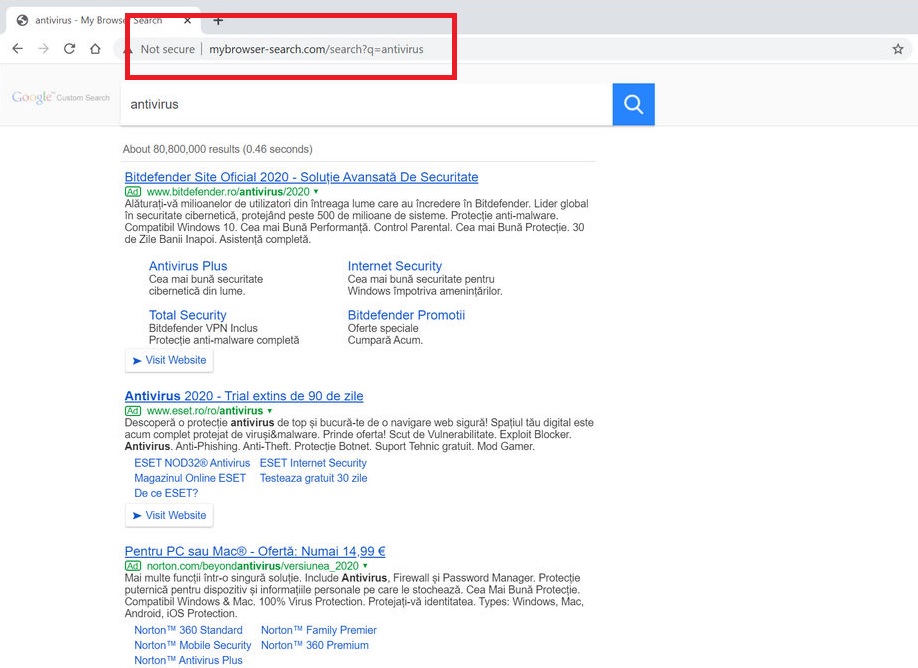Mybrowser
Mybrowser is a browser hijacker application which promotes itself as a helpful addition to browsers such as Safari, Chrome, Firefox or any other. However, some users have called Mybrowser application a “virus” and have reported some rather unwanted behavior related to its activities.

Some customers have had their browser homepage and/or search engine replaced by some sponsored ones promoted by Mybrowser without their permission and have noticed some new toolbars and new tab changes, which they have not approved. Such behavior is typical for applications from the browser hijacker type and is not intended to cause harm to the users and to their computers. Most hijackers are usually programmed to make changes to the users’ browsers in order to advertise certain tools, search engines, homepage domains or other sponsored ads, pop-ups and commercials. More often than not, applications like Mybrowser are able to gain the users’ direct (or indirect) permission to redirect them to certain promotional websites in order to boost those sites’ traffic and visitor counts. Many people, however, see such applications as potentially unwanted and seek methods to remove their changes and have them uninstalled mainly due to their aggressive page-redirects and invasive browser changes.
Mybrowser for Mac
The “infection” with a browser hijacker such as Mybrowser for Mac is definitely not as stealthy as the infection with a Ransomware or a Trojan virus. However, it may still happen in many ways and without you realizing it.
When you visit different ad-supported websites, freeware or shareware platforms or torrent sites, you may accidentally download and install such software, believing that you are adding a helpful feature to your browser. Performing a careless installation of a free program bundle is yet another way to invite an ad-generating software into your system. Different spam mail attachments, free download links and ads, when opened/clicked upon, may also prompt you to download and install such tools. That’s why you should be mindful of the software sources you use and carefully perform installations through the Advanced/Custom/Manual options only.
What is Mybrowser?
In most of the cases, if you are not paying enough attention, an application like Mybrowser may invade your system without specifically notifying you about getting installed. However, once it gets into your browser, it doesn’t hide like a Ransomware or a Trojan horse virus and you can easily detect it as it places its browser changes and starts to flood your screen with ads and redirects.
You may notice some new toolbars, desktop shortcuts or bookmarks, which you did not add previously. The default search engine may also get changed and you may be unable to access certain sites. Your hijacked browser may get slow and respond sluggishly. One of the most annoying things, however, is that every time you try to enter a specific web address, it may automatically get you redirected to some other sponsored pages, which may be completely unfamiliar to you and which you likely don’t want to visit. The objective behind this behavior is simple – to ensure that the browser hijacker can earn pay-per-click revenue by exposing you to specific promotional ads, pay-per-click links and websites and also by monitoring your online activities in order to later spam you with targeted commercials. This behavior is typical for most online advertising tools but if you don’t want to keep such software on your PC, you can remove it by following the instructions in the guide above and thus have all of the hijacker components completely uninstalled.
SUMMARY:
| Name | Mybrowser |
| Type | Browser Hijacker |
| Detection Tool |
Remove Mybrowser from Mac
You are dealing with a malware infection that can restore itself unless you remove its core files. We are sending you to another page with a removal guide that gets regularly updated. It covers in-depth instructions on how to:
1. Locate and scan malicious processes in your task manager.
2. Identify in your Control panel any programs installed with the malware, and how to remove them. Search Marquis is a high-profile hijacker that gets installed with a lot of malware.
3. How to clean up and reset your browser to its original settings without the malware returning. You can find the removal guide here.
For mobile devices refer to these guides instead: Android, iPhone

Leave a Reply